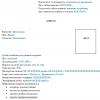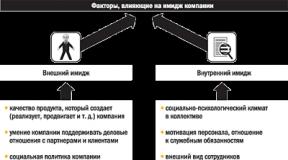Suprax® Solutab® dispersible tablets. Suprax solutab - instructions, indications, composition, method of administration Suprax capsules 400 mg
The active ingredient (INN) is cefixime.
List of analogues with the same active substance. The approximate prices of online pharmacies are shown in brackets:
- Pancef (600 rubles for 10 tab.);
- Pancef in the form of a suspension has a children's dosage;
- Ceforal Solutab (currently absent);
- Ixim Lupine (500 r for 5 servings, children's dosage).
In general, the antibiotic cefixime cannot be classified as a cheap drug. But in many cases, you can pick up another drug that will cost much less, for example: List of antibiotics for furunculosis.
Price
Average online price *, 806 r. (caps 400mg No. 6)
Where can I buy:
Instructions for use
(when the picture opens, click the button at the bottom of the screen)
Suprax is an antibacterial drug from the group of 3rd generation cephalosporins. The drug is widely used in the treatment of diseases of infectious and inflammatory origin.
Antibiotic Suprax has a pronounced bactericidal effect, belongs to drugs wide range action, which allows it to have an effect on almost all pathogenic microorganisms.
What is the difference
 The drug is produced in two forms:
The drug is produced in two forms:
- water-soluble tablets (Suprax Solutab);
- capsules (Suprax).
Both forms of the antibiotic contain 400 mg of cefixime, which forms the basis of the drug. There are slight differences in excipients. Both are intended for oral administration. Currently produced by the same manufacturer.
Solutab dissolves and absorbs faster, it can be chewed and has a strawberry aroma. It is believed to be better absorbed.
Solutab is available in 7 tablets per pack, ordinary Suprax - 6 capsules.
Indications
Medicinal product Suprax is widely used in various fields of medicine. It is often used to treat the following conditions:

- acute or exacerbation of chronic pharyngitis;
- sinusitis;
- sinusitis of varying degrees;
- sore throats;
- complications from the flu or viral infection;
- otitis;
- sharp or Chronical bronchitis;
- pneumonia;
- pyelonephritis;
- pyoderma and severe furunculosis;
- cystitis;
- uncomplicated gonorrheal urethritis.
The drug can be prescribed for skin infections and connective tissue, as well as other inflammatory diseases that are caused by microorganisms and bacteria that are sensitive to the drug.
Method of administration and dosage
The drug Suprax should be prescribed by a doctor individually for each patient, based on the diagnosis, body weight, and body characteristics.
Tablets
The dose of Suprax Solutab for adults and children over 18 years of age is 1 tablet (400 mg) per day. Sometimes, as directed by a doctor, a single dose is divided into 2 doses, 200 mg each. Drink with water.
If for any reason the patient cannot swallow the pill whole, it can be dissolved in 100 ml of warm water. In this case, it is also better to drink it with water.
Capsules 
Adults and children who have reached 12 years of age are prescribed 400 mg once a day or 200 mg twice a day.
When diagnosed with uncomplicated gonorrhea, a single dose of 400 mg (1 capsule) is prescribed.
If a person has a history of severe kidney disease or the patient is on hemodialysis, daily dose decreases by 25%.
The capsules should be taken whole with plenty of water. Doctors recommend taking the drug at the same time every day.
Before or after meals
All forms of Suprax can be taken both before, after, and during meals, in other words, regardless of the meal.
Duration
In infections of the ENT organs and the respiratory system, the duration of the drug intake is 6-14 days. If such diseases proceed with complications, then the therapeutic course will be up to 14 days.
In uncomplicated form of gonorrhea, the drug is taken once in a dose of 400 mg.
If after 3 days of taking the drug there is no improvement, you need to inform the doctor who can adjust the dose of the drug or choose another antibacterial drug... In the process of taking Suprax, you need to take probiotics that can protect the intestinal microflora from dysbiosis.
Contraindications
Suprax in the form of capsules or tablets has several contraindications, including:

- Individual intolerance to drugs from the group of cephalosporins or penicillins.
- Renal failure
- Children's age of a child's body weight, which is less than 25 kg.
This drug should be used with caution by persons over 60 years of age, as well as by those who have a history of severe kidney and cardiac disease. vascular system.
Application during pregnancy and breastfeeding
The drug is contraindicated at all times, except in cases where the intended benefit to the mother outweighs the risk to the child.
Alcohol compatibility
There is no data on a direct interaction of Suprax with alcohol, but one must take into account the double burden on the liver and the fact that alcohol aggravates any infectious diseases.
In addition, alcohol accelerates the elimination of antibiotics from the body, thus it is possible to "interrupt" the course of treatment, which should be continuous.
Side effects
Possible following symptoms:
- Hyperemia of the skin, itchy skin.
- Headache.
- Noise in ears.
- Nausea, vomiting.
- Digestive disorders.
- Dysbacteriosis.
- Anemia.
The appearance of the above symptoms is a reason to apply for medical help.
Overdose
With a slight intensity of symptoms, it is recommended to rinse the stomach, take a sorbent preparation. In more severe cases, the patient needs to be hospitalized.
Compound
 In the composition of Suprax, cefixime trihydrate at a dose of 400 mg acts as an active substance.
In the composition of Suprax, cefixime trihydrate at a dose of 400 mg acts as an active substance.
Excipients Suprax Solutab: microcrystalline cellulose, low-substituted hyprolose, colloidal silicon dioxide, povidone, magnesium stearate, calcium saccharinate trisesquihydrate, strawberry flavor (FA 15757 and PV 4284), sunset yellow dye (E110).
Excipients of Suprax capsules: colloidal silicon dioxide, magnesium stearate, calcium carmellose. The composition of the capsule shell: titanium dioxide, dye Azorubin (E122), dye Indigocarmine (E132), gelatin.
You can buy the drug in the form of capsules in a cardboard box containing blister No. 6.
Suprax Solutab tablets are sold in blisters of 7 tablets.
Storage conditions
Store the Suprax antibiotic in a dark place out of the reach of children at temperatures up to 25 ° C. The shelf life is no more than 3 years from the date of issue.
In pharmacies, the drug is available on prescription.
The active ingredient is cefixime trihydrate - 466 mg (equivalent to 400 mg cefixime).
Excipients:
Capsule contents: Calcium carboxymethyl cellulose (calcium carmellose), magnesium stearate, colloidal silicon dioxide.
Gelatin capsule: Titanium dioxide, azorubin, indigo carmine, gelatin, purified water, sodium lauryl sulfate, edible ink obtained using materials used in the pharmaceutical industry.
Description
Hard gelatin capsule, size (0), purple lid / white body, containing a mixture of fine granular powder to a compressed mass from white to light yellow in color with a characteristic odor. The code H808 is printed on the cap of the capsule.
pharmachologic effect"type =" checkbox ">
pharmachologic effect
Cefixime is a semi-synthetic cephalosporin antibiotic of the third generation with a wide spectrum of action. Cefixime acts bactericidal, inhibiting the synthesis of the cell membrane, is resistant to the action of beta-lactamases produced by most gram-positive and gram-negative bacteria.
In vitro and under conditions clinical practice Cefixime is usually effective against the following microorganisms:
Gram-positive: Streptococcus pneumoniae, Streptococcus pyogenes. Gram-negative: Haemophilus influenzae, Moraxella (Branhamella) catarrhalis, Escherichia coli, Proteus mirabilis, Neisseria gonorrhoeae.
In vitro, cefixime is usually effective against the following microorganisms: Gram-positive: Streptococcus agalactiae.
Gram negative: Haemophilus parainfluenzae, Proteus vulgaris, Klebsiella pneumoniae, Klebsiella oxytoca, Pasteurella multocida, Providencia spp., Salmonella spp., Shigella spp., Citrobacter amalonaticus, Citrobacter diversus, Serratia.
Note: Pseudomonas spp., Enterococcus (Streptococcus) serogroup D, Listeria monocytogenes, most staphylococci, including methicillin-resistant strains, Enterobacter spp., Bacteroides fragilis, Clostridium spp. resistant to cefixime.
Pharmacokinetics
When taken orally, the bioavailability of the drug ranges from 40 to 50% regardless of food intake, however, the maximum concentration of cefixime in serum is reached 0.8 hours faster when taking the drug with food.
When capsules are taken, the maximum serum concentration is reached after 4 hours and is 3.5 μg / ml.
The connection with plasma proteins, mainly albumin, is 65%.
The half-life depends on the dose and ranges from 3 to 4 hours.
About 50% is excreted by the kidneys unchanged, about 10% is excreted in the bile.
In case of impaired renal function - creatinine clearance (CC) of 20-40 ml / min, the half-life increases to 6.4 hours, with creatinine clearance of 5-10 ml / min - up to 11.5 hours.
Indications for use
Infectious and inflammatory diseases caused by microorganisms sensitive to the drug:
Pharyngitis, tonsillitis, sinusitis;
Acute and chronic bronchitis;
Otitis media;
Uncomplicated infections urinary tract;
Uncomplicated gonorrhea.
Contraindications
Hypersensitivity to cephalosporins and penicillins, childhood up to 12 years old, impaired renal function with CC less than 60 ml / min.
Carefully: elderly age, chronic renal failure, pseudomembranous colitis (history).
Pregnancy and lactation
The use of the drug during pregnancy is possible when the intended benefit to the mother outweighs the potential risk to the fetus.
If necessary, the appointment of the drug during lactation should stop breastfeeding.
Method of administration and dosage
Inside. In an average daily dose for adults and children over 12 years old with a body weight of more than 50 kg - 400 mg 1 time per day. Average duration the course of treatment is 7-10 days.
For diseases caused by Streptococcus pyogenes, the course of treatment is at least 10 days. For uncomplicated gonorrhea - 400 mg once.
In case of impaired renal function with CC less than 60 ml / min., Patients on hemodialysis or peritoneal dialysis are recommended to take Suprax® in suspension.
Side effect"type =" checkbox ">
Side effect
Allergic reactions: urticaria, skin flushing, pruritus, eosinophilia, fever, erythema multiforme (including Stevens-Johnson syndrome), toxic epidermal necrolysis (Lyell's syndrome), anaphylactic shock.
From the side nervous system: headache, dizziness, tinnitus.
From the side digestive system: dry mouth, anorexia, nausea, vomiting, diarrhea, constipation, flatulence, abdominal pain, dysbiosis, liver dysfunction, cholestasis, cholestatic jaundice, candidiasis, rarely stomatitis, glossitis, pseudomembranous enterocolitis.
From the side of hematopoietic organs: pancytopenia, leukopenia, neutropenia,
agranulocytosis, thrombocytopenia, hemolytic anemia, aplastic anemia, bleeding.
From the urinary system: interstitial nephritis, impaired renal function.
From the genitourinary system: vaginitis.
Laboratory indicators: increased activity of "hepatic" transaminases and alkaline phosphatase, hyperbilirubinemia, increased urea nitrogen, hypercreatininemia, increased prothrombin time.
Others: candidiasis, development of hypovitaminosis B, shortness of breath.
Overdose
Symptoms: Strengthening adverse reactions, especially from the gastrointestinal tract, with the exception of allergic reactions.
Treatment: gastric lavage, symptomatic and supportive therapy, which, if necessary, includes the use of antihistamines, glucocorticosteroids, epinephrine, norepinephrine, dopamine, oxygen therapy, transfusion of infusion solutions, artificial ventilation lungs. Cefixime is not excreted in large quantities from the circulating blood by hemo - or peritoneal dialysis.
Today, third generation cephalosporins, due to their effectiveness and spectrum of action, are perhaps the most demanded group of antibiotics. An obstacle to their popularity among the general population is the injection method of administering most of them. Suprax, a semi-synthetic antibiotic of the cephalosporin series, is devoid of this relative disadvantage, because intended for oral administration. Bactericidal action of this drug due to its ability to inhibit the synthesis of the main structural component of the bacterial cell membrane - peptidoglycan. The indisputable advantage of suprax is its protection from the harmful effects of beta-lactamases produced by bacteria.
Suprax is active against Streptococcus pyogenes, Streptococcus pneumoniae, Streptococcus agalactiae, Proteus vulgaris, Haemophilus influenzae, Haemophilus parainfluenzae, Klebsiella oxytoca, Klebsiella pneumoniae, Seridencia spp., Salvercia spp., Pasteurella spp., Pasteurella spp. marcescens, E. coli, Neisseria gonorrhoeae, Moraxella (Branhamella) catarrhalis, Proteus mirabilis. It is widely used in otolaryngology, pulmonology, urology, and pediatrics. The drug has high degree bioavailability and easily penetrates the bronchi, maxillary sinus, tonsils and the middle ear cavity. The half-life of suprax is longer than that of other cephalosporins, due to which the drug can be taken only once a day.
Suprax is available in two dosage forms: capsules and granules for oral suspension. The production of dispersible (soluble) tablets was also mastered under the name "Suprax Solutab". The suspension is used mostly in pediatric practice since it is easier and more pleasant (the presence of flavors) to take. Before use, the bottle with granules should be turned over and shaken well, then add in two portions (total - 40 ml) boiled water room temperature and shake until a homogeneous suspension is formed. You can use the resulting liquid for its intended purpose after 5 minutes, when the powder is completely dissolved. Shake naturally before use.
The experience of using cephalosporins shows a predisposition to allergy to them in those patients who are hyperreactive towards penicillins. As a rule, the duration of taking suprax does not exceed 7-10 days. With longer use, it is possible to suppress the development of normal intestinal microflora, accompanied by the uncontrolled growth of microorganisms resistant to the drug (for example, Clostridium difficile), which can cause diarrhea and pseudomembranous enterocolitis. Suprax is often used as the second stage of antibiotic therapy, when the first of them takes place in a hospital setting with the use of injectable antibacterial agents.
Pharmacology
Semisynthetic broad-spectrum cephalosporin antibiotic of the III generation for oral administration. It has a bactericidal effect. The mechanism of action is due to the inhibition of the synthesis of the cell membrane of the pathogen. Cefixime is resistant to β-lactamases produced by most gram-positive and gram-negative bacteria.
In vitro and in clinical practice, cefixime is active against gram-positive bacteria: Streptococcus pneumoniae, Streptococcus pyogenes; gram-negative bacteria: Haemophilus influenzae, Moraxella (Branhamella) catarrhalis, Escherichia coli, Proteus mirabilis, Neisseria gonorrhoeae.
In vitro, cefixime is active against gram-positive bacteria: Streptococcus agalactiae; gram-negative bacteria: Haemophilus parainfluenzae, Proteus vulgaris, Klebsiella pneumoniae, Klebsiella oxytoca, Pasteurella multocida, Providencia spp., Salmonella spp., Shigella spp., Citrobacter amalonaticus, Citrobacter diversceus, Serratia marcesceus
Pseudomonas spp., Enterococcus (Streptococcus) serogroup D, Listeria monocytogenes, Staphylococcus spp. Are resistant to cefexim. (including methicillin-resistant strains), Enterobacter spp., Bacteroides fragilis, Clostridium spp.
Pharmacokinetics
Absorption and distribution
When taken orally, the bioavailability of cefixime is 40-50% regardless of food intake, however, the C max of cefixime in serum is reached 0.8 hours faster when taking the drug with food.
When taking the drug in the form of capsules, C max in serum is reached after 4 hours and is 3.5 μg / ml.
When the drug is taken in the form of a suspension at a dose of 200 mg, serum C max is reached after 4 hours and is 2.8 μg / ml, when taken at a dose of 400 mg - 4.4 μg / ml.
Plasma protein binding, mainly albumin, is 65%.
Withdrawal
About 50% of the dose is excreted in the urine unchanged within 24 hours, about 10% of the dose is excreted in the bile.
T 1/2 depends on the dose and is 3-4 hours.
Pharmacokinetics in special clinical situations
In patients with impaired renal function, with CC from 20 to 40 ml / min, T 1/2 increases to 6.4 h, with CC 5-10 ml / min - up to 11.5 h.
Release form
Capsules with a purple cap and a white body; size No. 0; with the code "H808" applied in food ink; the contents of the capsules are a mixture of powder and small yellowish-white granules.
| 1 caps. | |
| cefixime (as trihydrate) | 400 mg |
Excipients: colloidal silicon dioxide - 4 mg, magnesium stearate - 2 mg, calcium carmellose - 16 mg.
The composition of the capsule shell: titanium dioxide 2%, dye azorubin (E122) 0.1398%, dye indigo carmine (E132) 0.1299%, gelatin up to 100%.
Food ink composition: shellac 11-13%, ethanol 15-18%, isopropanol 15-18%, butanol 4-7%, propylene glycol 1-3%, sodium hydroxide 0.05-0.1%, povidone 10-13%, titanium dioxide 32 -36%.
6 pcs. - blisters (1) - cardboard packs.
Dosage
For adults and children over 12 years of age with a body weight of more than 50 kg, the drug is prescribed at a dose of 400 mg 1 time / day.
For uncomplicated gonorrhea, 400 mg is prescribed once.
Patients with impaired renal function with CC less than 60 ml / min, who are on hemodialysis or peritoneal dialysis, should be prescribed the drug in the form of a suspension for oral administration.
Oral suspension
For children aged 6 months to 12 years, the drug is prescribed at a dose of 8 mg / kg of body weight 1 time / day or 4 mg / kg every 12 hours.
For children aged 5-11 years, the daily dose is 6-10 ml of suspension, at the age of 2-4 years - 5 ml, at the age of 6 months to 1 year - 2.5-4 ml.
For adults and children over 12 years of age weighing more than 50 kg, the drug is prescribed at a dose of 400 mg 1 time / day or 200 mg 2 times / day.
The average duration of the course of treatment is 7-10 days.
For infections caused by Streptococcus pyogenes, the course of treatment should be at least 10 days.
In case of impaired renal function (with CC 21-60 ml / min) or in patients on hemodialysis, the daily dose should be reduced by 25%.
With CC ≤20 ml / min or in patients on peritoneal dialysis, the daily dose should be reduced by 2 times.
Suspension preparation rules
Turn the bottle over and shake the contents. Add 40 ml of boiled water cooled to room temperature in 2 steps and shake after each addition until a homogeneous suspension is formed. After that, it is necessary to let the suspension settle for 5 minutes to ensure complete dissolution of the granules. Shake the finished suspension before use.
Overdose
Symptoms: intensification of the manifestations described side effects, especially from the digestive system, with the exception of allergic reactions.
Treatment: gastric lavage; carry out symptomatic and supportive therapy, which, if necessary, includes the use of antihistamines, GCS, epinephrine, norepinephrine, dopamine, oxygen therapy, transfusion of infusion solutions, mechanical ventilation. Cefixime is not excreted in large quantities from the circulating blood by hemo- or peritoneal dialysis.
Interaction
Tubular secretion blockers (allopurinol, diuretics) delay the excretion of cefixime by the kidneys, which can lead to an increase in the concentration of the drug in the blood plasma.
With the simultaneous use of cefixime and carbamazepine, the concentration of carbamazepine in the blood plasma increases.
Reduces the prothrombin index, enhances the effect of indirect anticoagulants.
Side effects
Allergic reactions: urticaria, skin flushing, pruritus, eosinophilia, fever, erythema multiforme (including Stevens-Johnson syndrome), toxic epidermal necrolysis (Lyell's syndrome), anaphylactic shock, reactions resembling serum sickness.
From the nervous system: headache, dizziness, tinnitus, convulsions.
From the digestive system: dry mouth, anorexia, nausea, vomiting, diarrhea, constipation, flatulence, abdominal pain, dysbiosis, liver dysfunction, cholestasis, cholestatic jaundice, candidiasis, stomatitis, glossitis, pseudomembranous enterocolitis.
From the hematopoietic system: pancytopenia, leukopenia, neutropenia, agranulocytosis, thrombocytopenia, hemolytic anemia, aplastic anemia, bleeding.
From the urinary system: interstitial nephritis, impaired renal function, acute renal failure.
From the reproductive system: vaginitis, itching of the genitals.
On the part of laboratory parameters: an increase in the activity of hepatic transaminases and alkaline phosphatase, hyperbilirubinemia, an increase in urea nitrogen, hypercreatininemia, an increase in prothrombin time.
Others: candidiasis, shortness of breath.
Indications
Infectious and inflammatory diseases caused by microorganisms sensitive to the drug:
- pharyngitis, tonsillitis, sinusitis;
- acute and chronic bronchitis;
- otitis media;
- uncomplicated urinary tract infections;
- uncomplicated gonorrhea.
Contraindications
- impaired renal function with CC less than 60 ml / min (for capsules);
- children under 12 years of age (for capsules);
- children's age up to 6 months (for suspension);
- hypersensitivity to cephalosporins and penicillins.
The drug should be prescribed with caution in elderly patients, with chronic renal failure, pseudomembranous colitis (in history).
Application features
Application during pregnancy and lactation
The use of Suprax during pregnancy is possible only if the intended benefit to the mother outweighs the potential risk to the fetus.
If necessary, the use of Suprax during lactation should stop breastfeeding.
Application for impaired renal function
Suprax should be prescribed with caution in patients with chronic renal failure.
In case of impaired renal function (with CC from 21 to 60 ml / min) or in patients on hemodialysis, the daily dose should be reduced by 25%.
With CC ≤ 20 ml / min or in patients on peritoneal dialysis, the daily dose should be reduced by 2 times.
Application in children
It is contraindicated to prescribe a suspension of the drug Suprax ® to children under the age of 6 months, capsules - to children under 12 years of age.
special instructions
With prolonged use of the drug, a violation is possible normal microflora intestines, which can lead to the growth of Clostridium difficile and cause the development of severe diarrhea and pseudomembranous colitis.
Patients with a history allergic reactions on penicillins, may be hypersensitive to cephalosporin antibiotics.
During treatment, a positive direct Coombs' reaction and a false positive urine glucose reaction are possible.
Patients with diabetes mellitus it should be borne in mind that the composition of the suspension includes sucrose: 15 g in 20 ml (400 mg).
Influence on the ability to drive vehicles and use mechanisms
Patients taking cefixime should be careful when administering vehicles and other activities potentially dangerous species activities requiring increased concentration of attention and speed of psychomotor reactions, taking into account the profile of side effects.
Composition and form of release
in a contour acheikova packing 6 pcs .; in a pack of cardboard 1 packing.
in dark glass bottles of 60 ml; in a cardboard box 1 bottle complete with a dosage spoon.
Description of the dosage form
200 mg capsules with a yellow cap and a white body, containing a mixture of powder and small yellowish-white granules.
400 mg capsules with a purple cap and a white body, containing a mixture of powder and small yellowish-white granules. The code H808 is applied to the capsule.
Granules for preparation of oral suspension: fine granules from white to cream color. After dilution, it is an almost white to creamy suspension with a sweet strawberry aroma.
Characteristic
Semisynthetic cephalosporin antibiotic of the third generation for oral administration.
pharmachologic effect
pharmachologic effect- bactericidal, antibacterial broad spectrum.Pharmacodynamics
Inhibits the synthesis of the cell membrane of the pathogen. Cefixime is resistant to beta-lactamases produced by most gram-positive and gram-negative bacteria.
In vitro cefixime is active against gram-positive bacteria: Streptococcus agalactiae; gram-negative bacteria: Haemophilus parainfluenzae, Proteus vulgaris, Klebsiella pneumoniae, Klebsiella oxytoca, Pasteurella multocida, Providencia spp., Salmonella spp., Shigella spp., Citrobacter amalonaticus, Citrobacter diversus, Serratia marcescens.
In vitro and in clinical practice, cefixime is active against gram-positive bacteria: Streptococcus pneumoniae, Streptococcus pyogenes; gram-negative bacteria: Haemophilus influenzae, Moraxella (Branhamella) catarrhalis, E. coli, Proteus mirabilis, Neisseria gonorrhoeae.
Resistant to the drug Pseudomonas spp., Enterococcus (Streptococcus) serogroup D, Listeria monocytogenes, majority Staphylococcus spp.(including methicillin-resistant strains), Enterobacter spp., Bacteroides fragilis, Clostridium spp.
Pharmacokinetics
When taken orally, the bioavailability of cefixime is 40-50% regardless of food intake, however, the C max of cefixime in serum is reached 0.8 hours faster when the drug is taken with food.
When the drug is taken in the form of capsules at a dose of 200 mg, C max in serum is reached after 4 hours and is 2 μg / ml, when taken at a dose of 400 mg, it is 3.5 μg / ml. When the drug is taken in the form of a suspension at a dose of 200 mg, C max in serum is reached after 4 hours and is 2.8 μg / ml, when taken at a dose of 400 mg - 4.4 μg / ml. Plasma protein binding, mainly albumin, is 65%.
About 50% of the dose is excreted in the urine unchanged within 24 hours, about 10% of the dose is excreted in the bile. T 1/2 depends on the dose and is 3-4 hours.
In patients with impaired renal function, with Cl creatinine 20-40 ml / min, T 1/2 increases to 6.4 hours, with Cl creatinine 5-10 ml / min - up to 11.5 hours.
Indications of the drug Suprax ®
Infectious and inflammatory diseases caused by microorganisms sensitive to the drug:
pharyngitis, tonsillitis, sinusitis;
acute and chronic bronchitis;
otitis media;
uncomplicated urinary tract infections;
uncomplicated gonorrhea.
Contraindications
Hypersensitivity to cephalosporins and penicillins.
Carefully:
elderly age;
chronic renal failure;
pseudomembranous colitis (history);
children's age (up to 6 months).
Application during pregnancy and lactation
Use during pregnancy is possible only if the intended benefit to the mother outweighs the potential risk to the fetus.
If necessary, use during lactation should stop breastfeeding.
Side effects
Allergic reactions: urticaria, skin flushing, pruritus, eosinophilia, fever.
From the digestive system: dry mouth, anorexia, nausea, vomiting, diarrhea, flatulence, abdominal pain, dysbiosis, liver dysfunction (increased activity of hepatic transaminases, alkaline phosphatase, hyperbilirubinemia, jaundice), gastrointestinal candidiasis; rarely - stomatitis, glossitis, pseudomembranous enterocolitis.
From the side of the hematopoietic organs: leukopenia, neutropenia, thrombocytopenia, hemolytic anemia.
From the urinary system: interstitial nephritis.
From the nervous system: dizziness, headache.
Interaction
Tubular secretion blockers (allopurinol, diuretics, etc.) delay the excretion of cefixime by the kidneys, which can lead to increased toxicity.
Reduces the prothrombin index, enhances the effect of indirect anticoagulants.
Method of administration and dosage
Inside. For adults and children over 12 years old weighing more than 50 kg, the average daily dose is 400 mg (1 time per day or 200 mg 2 times a day). The average duration of the course of treatment is 7-10 days.
For uncomplicated gonorrhea- 400 mg once a day.
Children under the age of 12 are prescribed as a suspension at a dose of 8 mg / kg once or in 2 divided doses (4 mg / kg every 12 hours). For children aged 6 months to 1 year, the daily dose of the suspension is 2.5-4 ml, at the age of 2-4 years - 5 ml, at the age of 5-11 years - 6-10 ml. For diseases caused Streptococcus pyogenes, the course of treatment is at least 10 days.
In case of impaired renal function, the dose is set depending on the serum creatinine clearance rate: with Cl creatinine 21-60 ml / min or in patients on hemodialysis, the daily dose should be reduced by 25%. When Cl creatinine is less than or equal to 20 ml / min or in patients on peritoneal dialysis, the daily dose should be reduced by 2 times.
Suspension preparation method: turn the bottle over and shake the powder. Add 40 ml of boiled water cooled to room temperature in 2 steps and shake after each addition until a homogeneous suspension is formed. After that, it is necessary to let the suspension settle for 5 minutes to ensure complete dissolution of the powder. Shake the finished suspension before use.
Overdose
Symptoms: increased risk of adverse reactions.
Treatment: gastric lavage; symptomatic and supportive therapy, which, if necessary, includes the use of antihistamines, GCS, pressor amines, oxygen therapy, transfusion of infusion solutions, mechanical ventilation. It is not excreted in significant quantities by hemo- or peritoneal dialysis.
special instructions
Patients with a history of allergic reactions to penicillins may have an increased sensitivity to cephalosporin antibiotics.
With prolonged use of the drug, a violation of the normal intestinal microflora is possible, which can lead to growth Clostridium difficile, cause severe diarrhea and pseudomembranous colitis.
During treatment, a positive direct Coombs' reaction and a false positive urine glucose reaction are possible.
Manufacturer
Hikma Pharmaceuticals (Jordan) commissioned by Gedeon Richter-RUS CJSC.
Storage conditions of the drug Suprax ®
At a temperature not exceeding 25 ° C.Keep out of the reach of children.
Shelf life of the drug Suprax ®
3 years.Do not use after the expiration date printed on the package.
Synonyms for nosological groups
| ICD-10 heading | Synonyms of diseases according to ICD-10 |
|---|---|
| A54 Gonococcal infection | Gonococcal infections |
| Disseminated gonococcal infection | |
| Disseminated gonorrheal infection | |
| H66 Suppurative and unspecified otitis media | Bacterial ear infections |
| Inflammation of the middle ear | |
| ENT infections | |
| Infectious and inflammatory diseases of ENT organs | |
| Infectious and inflammatory ear diseases | |
| Infectious diseases of the ENT organs with severe pain syndrome | |
| Ear infection | |
| Otitis media infectious | |
| Persistent otitis media in children | |
| Ear pain with otitis media | |
| J01 Acute sinusitis | Inflammation paranasal sinuses nose |
| Inflammatory diseases of the paranasal sinuses | |
| Purulent-inflammatory processes of the paranasal sinuses | |
| Infectious and inflammatory disease of ENT organs | |
| Sinus infection | |
| Combined sinusitis | |
| Exacerbation of sinusitis | |
| Acute sinus inflammation | |
| Acute bacterial sinusitis | |
| Acute sinusitis in adults | |
| Subacute sinusitis | |
| Acute sinusitis | |
| Sinusitis | |
| J02.9 Acute pharyngitis unspecified | Purulent pharyngitis |
| Lymphonodular pharyngitis | |
| Acute rhinopharyngitis | |
| J03.9 Acute tonsillitis, unspecified (angina agranulocytic) | Angina |
| Alimentary-hemorrhagic angina | |
| Sore throat secondary | |
| Angina primary | |
| Follicular angina | |
| Sore throats | |
| Bacterial tonsillitis | |
| Throat infections | |
| Catarrhal sore throat | |
| Lacunar angina | |
| Acute sore throat | |
| Acute tonsillitis | |
| Tonsillitis | |
| Acute tonsillitis | |
| Tonsillar sore throat | |
| Follicular tonsillitis | |
| Follicular tonsillitis | |
| J20 Acute bronchitis | Acute bronchitis |
| Viral bronchitis | |
| Disease of the bronchi | |
| Infectious bronchitis | |
| Acute bronchial disease | |
| J31.2 Chronic pharyngitis | Atrophic pharyngitis |
| Inflammatory process of the pharynx | |
| Hypertrophic pharyngitis | |
| Infectious and inflammatory diseases of the pharynx | |
| Infectious and inflammatory diseases of the oral cavity and pharynx | |
| Pharyngeal infection | |
| Exacerbation of inflammatory diseases of the pharynx and oral cavity | |
| Pharyngitis is chronic | |
| J32 Chronic sinusitis | Allergic rhinosinusopathy |
| Purulent sinusitis | |
| Catarrhal inflammation of the nasopharyngeal region | |
| Catarrh of the paranasal sinuses | |
| Exacerbation of sinusitis | |
| Chronic sinusitis | |
| J35.0 Chronic tonsillitis | Chronic angina |
| Inflammatory diseases of the tonsils | |
| Chronic tonsillitis | |
| Tonsillar sore throat | |
| Chronic hypertrophic tonsillitis | |
| J42 Chronic bronchitis, unspecified | Allergic bronchitis |
| Astmoid bronchitis | |
| Allergic bronchitis | |
| Asthmatic bronchitis | |
| Chronic bronchitis | |
| Inflammatory disease respiratory tract | |
| Disease of the bronchi | |
| Smoker's qatar | |
| Cough in inflammatory diseases of the lungs and bronchi | |
| Exacerbation of chronic bronchitis | |
| Recurrent bronchitis | |
| Chronic bronchitis | |
| Chronic obstructive pulmonary disease | |
| Chronical bronchitis | |
| Chronic bronchitis of smokers | |
| Chronic spastic bronchitis | |
| N39.0 Urinary tract infection without localization | Asymptomatic bacteriuria |
| Bacterial urinary tract infections | |
| Bacterial infections urinary tract | |
| Bacterial infections of the genitourinary system | |
| Bacteriuria | |
| Bacteriuria, asymptomatic | |
| Chronic latent bacteriuria | |
| Asymptomatic bacteriuria | |
| Asymptomatic massive bacteriuria | |
| Inflammatory urinary tract disease | |
| Inflammatory disease of the genitourinary tract | |
| Inflammatory diseases Bladder and urinary tract | |
| Inflammatory diseases of the urinary system | |
| Inflammatory diseases of the urinary tract | |
| Inflammatory diseases of the urogenital system | |
| Fungal diseases of the urogenital tract | |
| Fungal infections of the urinary tract | |
| Urinary tract infections | |
| Urinary tract infections | |
| Urinary tract infections | |
| Urinary tract infections | |
| Urinary tract infections | |
| Urinary tract infections caused by enterococci or mixed flora | |
| Uncomplicated urinary tract infections | |
| Complicated urinary tract infections | |
| Infections of the genitourinary system | |
| Urogenital infections | |
| Urinary tract infections | |
| Urinary tract infection | |
| Urinary tract infection | |
| Urinary tract infection | |
| Urinary tract infection | |
| Urinary tract infection | |
| Urogenital tract infection | |
| Uncomplicated urinary tract infections | |
| Uncomplicated urinary tract infections | |
| Uncomplicated urinary tract infections | |
| Exacerbation of a chronic urinary tract infection | |
| Retrograde kidney infection | |
| Recurrent urinary tract infections | |
| Recurrent urinary tract infections | |
| Recurrent urinary tract infections | |
| Mixed urethral infections | |
| Urogenital infection | |
| Urogenital infectious and inflammatory disease | |
| Urogenital mycoplasmosis | |
| Urological disease of infectious etiology | |
| Chronic urinary tract infection | |
| Chronic pelvic inflammatory disease | |
| Chronic urinary tract infections | |
| Chronic infectious diseases of the urinary system |
The active ingredient of Suprax is cefixime.
Pharmacological properties
Suprax - refers to the semi-synthetic antibiotics of the cephalosporin series.
Shows a pronounced bactericidal effect.
Has a destructive effect on many gram-negative, gram-positive microorganisms.
Indications
Infectious and inflammatory diseases caused by microorganisms sensitive to the drug:
- acute bronchitis and chronic bronchitis;
- sinusitis;
- acute otitis media;
- streptococcal tonsillitis and pharyngitis;
- uncomplicated gonorrhea;
- uncomplicated urinary tract infections;
- shigellosis.
Release form
Dispersible tablets of 400 mg No. 1, No. 5, No. 7, No. 10 (5x2).
Mode of application
The duration of the course of treatment is determined by the doctor individually, depending on the severity of the course of the disease.
The tablet can be swallowed with water or diluted in water.
The drug can be used regardless of food intake.
Adults and children over 12 years old - the daily dose is 400 mg in 1 or 2 doses.
The course of treatment for infections of the respiratory tract and ENT organs is 7-14 days.
For uncomplicated infections of the lower urinary tract in women, the drug is prescribed for 3-7 days, the upper urinary tract - 14 days.
For infections of the upper and lower urinary tract in men, the duration of treatment is 7-14 days.
Children
Contraindicated for use in children under 12 years of age.
Use during pregnancy or lactation
Use during pregnancy or lactation only if the benefit to the mother outweighs the potential risk to the fetus or baby.
If necessary, use during lactation should stop breastfeeding.
Application features
The drug is used with caution in patients with severe renal failure, patients on hemodialysis or peritoneal dialysis.
Contraindications
- hypersensitivity to active substance or any other of the excipients of the drug;
- porphyria.
Side effects
When using, such side reactions may occur.
- nausea, vomiting, diarrhea, heartburn;
- indigestion, abdominal pain;
- headache, dizziness;
- hives, skin rashes, itching;
- increased body temperature, swelling of the face;
- transient leukopenia , agranulocytosis, pancytopenia.
Interaction with other medicinal products and other forms of interaction
When using cefixime with probenecid (and other tubular secretion blockers), the excretion of cefixime through the kidneys slows down, which can lead to symptoms of an overdose.
Cefixime reduces the prothrombin index, enhances the effect of indirect anticoagulants.
Furosemide, aminoglycosides increase the toxic effect of cefixime.
The ability to influence the reaction rate when driving or driving other mechanisms
Taking the drug can cause dizziness, drive a car and engage in activities requiring increased concentration of attention and speed of psychomotor reactions is not recommended.
Overdose
In case of an overdose of the drug, the risk of occurrence side effects... Symptomatic therapy is indicated.



















